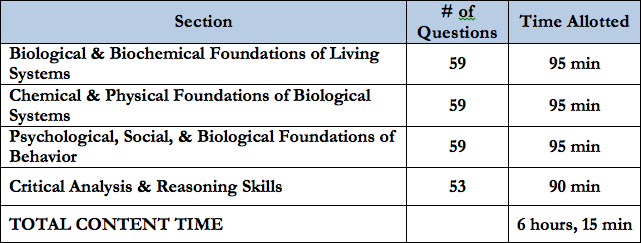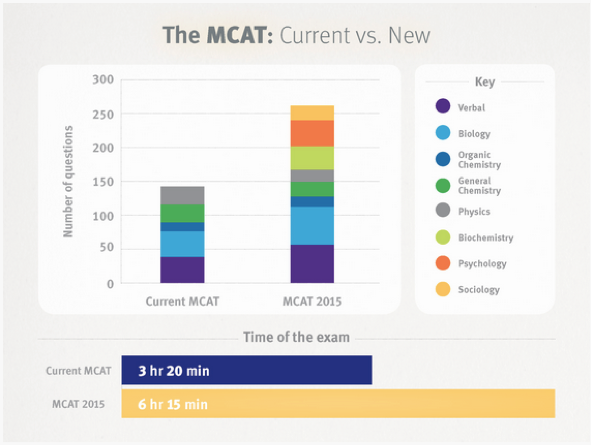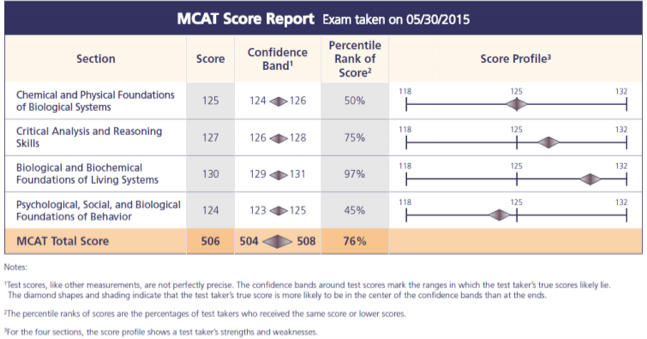The Association of American Medical Colleges, or AAMC, officially launched a new version of the MCAT, called the MCAT2015 on April 17, 2015. Approximately 8,200 individuals took this new version of the exam. The test has been changed for the first time since 1991, and AAMC is calling it “a better test for tomorrow’s doctors.” It was designed “to help better prepare tomorrow’s doctors for the rapidly advancing and transforming health care system.”
New Structure of the MCAT2015
The MCAT has changed in several major ways. Most notably, it has doubled in length. The MCAT2015 consists of 230 questions over 6 hours and 15 minutes, whereas the previous version consisted of 144 questions over 3 hours and 20 minutes. But despite the greater overall length, students taking the newer exam actually have more time to complete each question.
The MCAT2015 includes both new topic areas and different types of questions. The first three sections are organized around “big ideas” in the sciences. According to the AAMC, these sections “reflect current research about the most effective ways for students to learn and use science, emphasizing deep knowledge of the most important scientific concepts over knowledge simply of many discrete facts.”
Here is a sample question from the MCAT2015 from the section, “Chemical & Physical Foundations of Biological Systems.” It focuses on using scientific theories and models to solve a specific problem.
The radius of the aorta is about 1.0 cm and blood passes through it at a velocity of 30 cm/s. A typical capillary has a radius of about 4 10-4 cm with blood passing through at a velocity of 5 10-2 cm/s. Using this data, what is approximate number of capillaries in a human body?
- 1 104
- 2 107
- 4 109
- 7 1012
The new sections will also test additional skills, including research design, graphical analysis and data interpretation. Kaplan claims that the “passages will be restructured to test all of the natural sciences within biological systems,” giving the test a more medical focus by showing the application of the sciences to medicine.
The new section, “Psychological, Social, and Behavioral Foundations of Behavior,” comprises 25% of the test, and recognizes the role of social science in treating patients effectively. Catherine Lucey, a member of the MCAT review committee and vice dean of the UC San Francisco School of Medicine, observes:
“One hundred years ago, all you really needed to know was the science. We were all looking for the magic bullet that would cure disease. Now we have problems like obesity and diabetes that require doctors to form therapeutic alliances with patients and convince them to change their lifestyle.”
Ripal Shah, an MCAT test prep tutor for Advantage Testing, agrees that training in the social sciences is beneficial for a career in medicine, because “many studies have shown that communication skills are often the most indicative of patient satisfaction and medication compliance.”
The following visual, from Kaplan Test Prep, illustrates the structural and content changes between the two tests.
The US News blog, “Medical School Admissions Doctor,” estimates that the vast amount of information covered on the MCAT2015 requires significantly more than standard medical school prerequisites:
- One year of biology, chemistry, organic chemistry, and physics
- One semester of biochemistry, psychology, and sociology,
- A year of humanities (recommended)
Score Scale
Each of the four sections will be scored individually, from 118 to 132, with a midpoint of 125. Scores are combined to create a total score ranging from 472 to 528, with a midpoint of 500. The new score reports will provide details on your test performance. “The AAMC envisions a score report that will bring together MCAT scores, percentile ranks, confidence bands, and score profiles in a way that highlights applicants’ strengths and weaknesses.” The MCAT Score Report Prototype released by the AAMC illustrates each of these aspects of scoring on a sample score report.
Percentile ranks are included so examinees can compare their performance to others who took the new exam. Confidence bands show the ranges of scores an examinee could expect on another MCAT attempt. Score profiles provide information about applicants’ strengths and weaknesses across the four sections of the exam.
Applying to medical school is a long and challenging process. Not to mention competitive: just under 50,000 students applied to medical school in 2014, with an average MCAT score of 28.6 and GPA of 3.55. Of those accepted, the mean MCAT score was 31.4, with a 3.69 GPA.
For more information or guidance regarding the MCAT, or any other aspect of the admissions process, contact Collegiate Gateway – we’re always happy to help.



